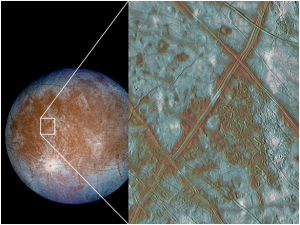WEDNESDAY, 25 JANUARY 2012
Scientists suspect that Jupiter’s icy moon has a salt water ocean 10-30km beneath the ice crust that contains more liquid water than all of Earth's oceans combined. However, Europa is so far from the Sun that its surface is covered with an ice sheet thought to be tens of miles thick. A thick ice layer makes aquatic life difficult as energy and nutrients can’t circulate between the moon’s surface and its ocean.Now a team lead by Britney Schmidt from the Institute for Geophysics, University of Texas at Austin, has been using images from the Galileo spacecraft to analyse circular, bumpy features on the surface of Europa called ‘chaos terrains’. Chaos terrains are seen on Earth in ice shelves and glaciers that cover volcanoes, and indicate an area of thinner ice. The team have now developed and published a model in Nature, which may explain these phenomena on Europa’s thick ice sheet. They theorise that plumes of warmer water rise from the moon’s depths, melting and fracturing the ice sheet and enabling Europa’s icy crust and ocean to mix vigorously. This allows the transfer of energy and nutrients that favour life.
The model resolves previously conflicting observations of Europa’s ocean; some of which had suggested that the ice shell is thick, others that it is thin. As the current model depends on the analysis of images of the surfaces of Europa and Earth, however, the existence of these plumes can only be confirmed by a future spacecraft mission to probe the ice shell.
Written by Joanna-Marie Howes
DOI: 10.1038/nature10608

